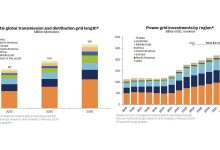Climate Neutrality: 7 TW of Green Capacity and USD 5 Trillion Worth of Investment by 2030
Investment in renewable energy needs to triple by 2050 to put the world on a trajectory to reach the goal of climate neutrality by mid-century, according to a new report by the United Nations’ World Meteorological Organization (WMO). Radically transforming the global energy system requires a significant increase in annual energy investment from just over USD 2,000 billion (USD 2 trillion) globally to nearly USD 5,000 billion (USD 5 trillion) by 2030, the agency says, to have 7 TW installed in renewable power plants by 2030.
The WMO’s annual State of Climate Services Report also notes that electricity supply from clean energy sources needs to double in the next eight years to limit global temperature rise. Otherwise, there is a risk that climate change, extreme weather and water stress will undermine the world’s energy security and even jeopardize renewable energy supplies.
“The energy sector is the source of around three-quarters of global greenhouse gas emissions. Switching to clean forms of energy generation, such as solar, wind and hydropower, and improving energy efficiency is vital if we are to thrive in the twenty-first century. Net zero by 2050 is the aim. But we will only get there if we double the supply of low-emissions electricity within the next eight years. Time is not on our side, and our climate is changing before our eyes. We need a complete transformation of the global energy system,” said WMO Secretary-General Prof Petteri Taalas.
Climate plans ignore energy
By 2050, global electricity needs, which will continue to grow over the years, will mainly be met by renewable energy, with solar energy being the largest source of supply, the report says. Although climate action plans should prioritize energy, only 40% of the plans submitted by governments to the United Nations Framework Convention on Climate Change (UNFCCC), which entered into force in November 2016, prioritize adaptation in the energy sector and investment is consequently low.
New capacity needed
Energy security has risen to the top of governments’ priority lists as a result of geopolitical instability and rising gas prices. Therefore, governments around the world are trying to accelerate and expand the scope of their renewable energy programs to help reduce dependence on imported energy. Renewable energy investment commitments are now less than half of what is needed, and 7.1 TW of green energy capacity needs to be installed by 2030 to meet the Paris Agreement’s long-term global temperature target, according to figures cited in the report.
If we consider that Romania currently has an installed capacity of about 18,000 MW in conventional power plants for energy production, the need for renewable capacity would mean a capacity by 390 times higher than Romania’s.
Developing countries, reduced funding
Policies and regulations needed to enable decarbonization in the energy sector are still particularly weak in Africa, South America, and Asia, according to the World Bank. During 2019-2020, most investments in renewable energy were made in the East Asia and Pacific region (mainly China and Japan), followed by Western Europe and North America. International public financial flows to developing countries in support of clean energy fell in 2019 for the second year in a row, to USD 10.9 billion. This level of support was 23% less than the amount of USD 14.2 billion provided in 2018, 25% less than the 2010-2019 average, and less than half the peak of USD 24.7 billion in 2017.
Developing countries are under-represented when it comes to accessing clean energy finance, the report says, pointing out that Africa could be a major player in renewable energy. Africa is home to 60% of the world’s best solar resources but has only 1% of the world’s installed PV capacity, it notes.
By 2030, 45% of energy must come from renewable sources
With REPowerEU, the European Commission aims for 45% of the EU’s energy to come from renewable sources by 2030, more than half the current level. Hundreds of billions of euros are needed to achieve this goal, also invested with the support of the EU, which allocates significant funds to member countries. These costs will be partly offset by annual savings of EUR 84 billion from reduced imports of fossil fuels, the EU plan says.
Launched in March 2022 and approved in May, the REPowerEU plan is based on two main arguments for urgently transforming Europe’s energy system: the need to eliminate the EU’s dependence on fossil fuel imports from Russia and the need to manage the climate crisis.
Romania to increase its renewable energy target
Romania’s renewable energy target for 2030 could be increased from the current level of 30.5% to 34%. To this end, Ministry of Energy officials have announced that the Integrated National Energy and Climate Plan (NECP) will be revised between 2023 and 2024 to take into account the European Commission’s recommendations in the REPowerEU plan.
“We want to install 950 MW of capacity by 2024. We will start updating the Integrated National Energy and Climate Plan this year, and the 30.5% target will be significantly increased,” Secretary of State in the Ministry of Energy Dan Dragan said in spring.
What Brussels is proposing
In order to accelerate the transition to green energy, the European Commission has proposed that 45% of energy generated in the EU bloc should come from renewable sources by 2030, replacing the previous proposal of 40%.
In 2020, the EU obtained 22% of its energy from renewable sources such as wind, solar and biomass. The new target aims to more than double the EU bloc’s capacity to generate energy from such sources by 2030 and for wind power to become the EU’s main source of electricity. To achieve this goal, the EU executive has proposed a law to simplify the licensing of wind and solar projects and eliminate the delays that some have faced for years.
Member countries will also be obliged to add solar panels on public and commercial buildings from 2025 and on new housing from 2029.
The European Commission is also proposing a binding target to reduce EU energy consumption by 13% by 2030, replacing the previous target of just 9%. These proposals will have to be approved by Member States.







